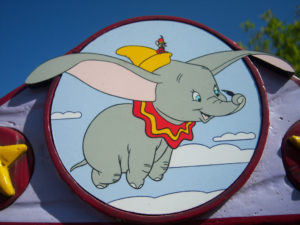In the 1941 movie, Dumbo, a little elephant with big ears could fly. However, he only believed it was possible when he held a magic feather in his trunk. The feather was his source of confidence and comfort. It provided a secure touchpoint and reminded him of what was possible.
Then one day, mid-flight, the feather slipped, and Dumbo discovered that he could fly all along.
Sometimes we need something to remind us that we can soar too.
When we are trying to make a change for the good, we can deliberately connect the desired internal response with an external trigger.
To overcome a fear of public speaking, you can enter the room early, find a sprinkler head or exit sign, and link that fixture in your head to whatever it is you need to be successful. It could be an assurance that you are prepared. It might be the first line of each transition of your talk. Maybe it is just a reminder to breath. Then during the presentation, if a general feeling of nervousness arises or someone asks a difficult question, you need only glance at that light switch in the back of the hall. Rather than lose your focus, you suddenly are enveloped in centering calm. You may even silently chuckle at your secret. You have invested all the safety, security and cues you need in the lifeless features of an otherwise common room.
Therapists, and practitioners of neuro-linguist programing, call this setting an “anchor”. Anchors can come in any number of internal or external forms. We can take an inanimate object or phrase, a touch or a sound, and deliberately infuse it with whatever associations are required to pair it to the desired outcome. Then all we need to do is open our awareness of the trigger, and all the meaning we have given it comes flooding back. Like the anchor of a ship, it becomes a point of stability, enabling us to remain steady and secure in the midst of whatever tempests rage.
 Setting our own Dumbo’s feather, our own anchors can help us to remain calm before an interview. They can steady our hand and voice when asking someone out on a date. Anchors can assist us we adopt new behaviors or change habits too. Often when my coaching clients want to increase their confidence, remember to slow down, or be more attentive to their teams, they will invest whatever reminders and affirmations they need in a piece of jewelry, or in a candy dish on the corner of their desk. Then all it takes is a glance, the twist of ring, or someone reaching for a mint, and they are refocused and reinvigorated in their resolve and commitment toward their goal.
Setting our own Dumbo’s feather, our own anchors can help us to remain calm before an interview. They can steady our hand and voice when asking someone out on a date. Anchors can assist us we adopt new behaviors or change habits too. Often when my coaching clients want to increase their confidence, remember to slow down, or be more attentive to their teams, they will invest whatever reminders and affirmations they need in a piece of jewelry, or in a candy dish on the corner of their desk. Then all it takes is a glance, the twist of ring, or someone reaching for a mint, and they are refocused and reinvigorated in their resolve and commitment toward their goal.
Dumbo’s power to fly, and our power to change, does not come from any magic feather. But we can create anchors around us every day to remind us of our commitments and purpose and abilities, and to drive us to greater success and happiness.
©2017 John Albert Doyle, Jr. All Rights Reserved.
Image Credits
Dumbo the Flying Elephant by Loren Javier/Flickr made available via a Creative Commons Attribution-NoDerivs 2.0 Generic License.
Morning by Hartwig HKD/Flickr made available via a Creative Commons Attribution-NoDerivs 2.0 Generic License.
Additional readings
For more on setting anchors, see Robert Dilts’ “Article of the Month” on Anchoring found here, or the Derbyshire Community Health Services article entitled “Using Anchors” found here.





